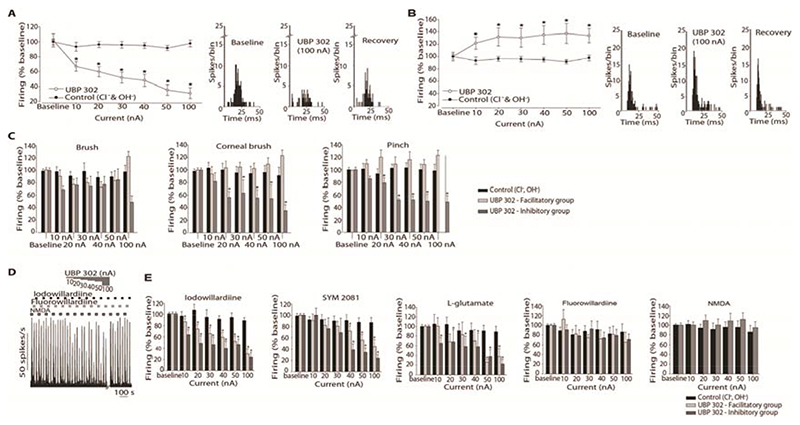Figure 4.
Effect of microiontophoresis of UBP302 on responses of trigeminocervical neurons to middle meningeal artery stimulation and to receptive field characterisation. Ejection of UBP302 produced two opposing responses. A. In 15 units ejection of UBP302 demonstrated a dose dependent inhibition of the cell firing, maximally at 100 nA. B. In 12 neurons UBP302 significantly potentiated cell firing. Control vehicle had no effect. Post-stimulus histograms from representative cluster of neurons in the inhibitory (A) and facilitatory (B) groups, recorded pre- UBP302 ejection, during ejection of UBP302 at 100 nA, and 30 minutes after the cessation of ejection. C. Effects of microiontophoretically delivered UBP302 and its vehicle control (Cl-, OH-) on the firing rates of second order neurons in response to receptive field characterisation. Cell firing in response to light brush was not altered by microiontophoretically administered UBP302 neither in the inhibitory group nor in the facilitatory group. Cell firing in response to pinch and to corneal stimulation was significantly inhibited by microiontophoretically administered UBP302 in the inhibitory group. Noxious-evoked responses to both pinch and corneal stimulus were not significantly facilitated across the cohort in the facilitatory group. Control ejection had no significant effect. D. Example of the effects of UBP302 on the firing rates to pulsed ejections of fluorowillardiine, iodowillardiine and NMDA. Cell firing in response to the ejected agonists returned to baseline levels within 30 minutes after UBP302 microiontophoresis ceased. E. Comparison of the current-response curves for UBP302 and control (Cl- and OH-) on iodowillardiine, SYM 2081, L-glutamate , fluorowillardiine and NMDA evoked responses. Overall, cell firing in response to iodowillardiine (n = 19), SYM 2081 (n = 18) and L-glutamate (n = 18) was significantly inhibited by microiontophoretically administered UBP302, and there was no significant difference between the inhibitory and the facilitatory groups. Cell firing in response to fluorowillardiine (n = 17) and NMDA (n = 6) was unaffected by microiontophoretically delivered UBP302. Vehicle control had no significance on any agonist-evoked firing. * P < 0.05

